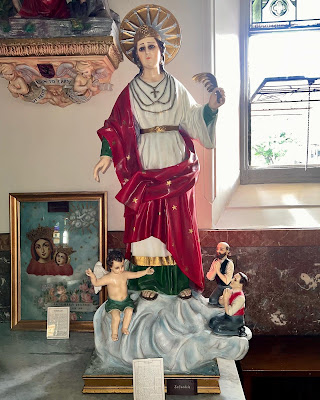La Comunità di Ventotene emigrata negli Stati Uniti come quella di Ponza con San Silverio, hanno portato la loro Protettrice, Santa Candida.
Qui un pò di storia:
"According to the roman martirology St candida was martyred at the end of third century in Cartage, Africa on september 20. Tradition holds her body was buried in a well, later called "The well of St Candida" in an inlet along the harbor of the island of Ventotene off the coast of Naples. The island of Ventotene had been inhabited since ancient roman times as attested by ruins of the period. Since these ancient times the inhabitants developed a veneration of St Candida. Althought the island was later abandoned, the citizens of neighboring Ischia presered her memory. Sometime around the year 1740, Pasquale Regine, his twelve years old son Vincenzo and five others ventured to the abandoned island by small boat to gather fire wood. As the boat approached shore they were captured by tunisian named Corsari and brought to Tunisia enslaved. Vincenzo was set free after a year and Pasquale returned to Ischia two years later.
In 1790, Ferdinand IV, the King of Naples, repopulated Ventotene in order to discourage pirate of a safe haven. Pasquale went with his family, and giving thanks to St Candida for his freedom, had a statue constructed keeping it on his farm and in 1820 was brought to the parocchial church where is still remain.In 1943, as an act of faith and in order to uphold this devotion and veneration, Rosa Romano, had a facsimile statue made and placed in Sacred Hearts St Stephen, where on the Sunday preceding the feast day, mass is celebrated in honour of St Candida."
Nel 1790 Ferdinando IV, re di Napoli, ripopolò Ventotene per scoraggiare i pirati di un porto sicuro. Pasquale si recò con la famiglia e, ringraziando Santa Candida per la sua libertà, fece costruire una statua che custodiva nel suo podere e nel 1820 fu portata nella chiesa parrocchiale dove si trova tuttora.
Nel 1943, come atto di fede e per sostenere questa devozione e venerazione, Rosa Romano, fece realizzare una statua in facsimile e collocarla nel Sacro Cuore di Santo Stefano, dove la domenica precedente la festa viene celebrata la messa in onore di Santa Candida.



Nessun commento:
Posta un commento
I vostri pensieri